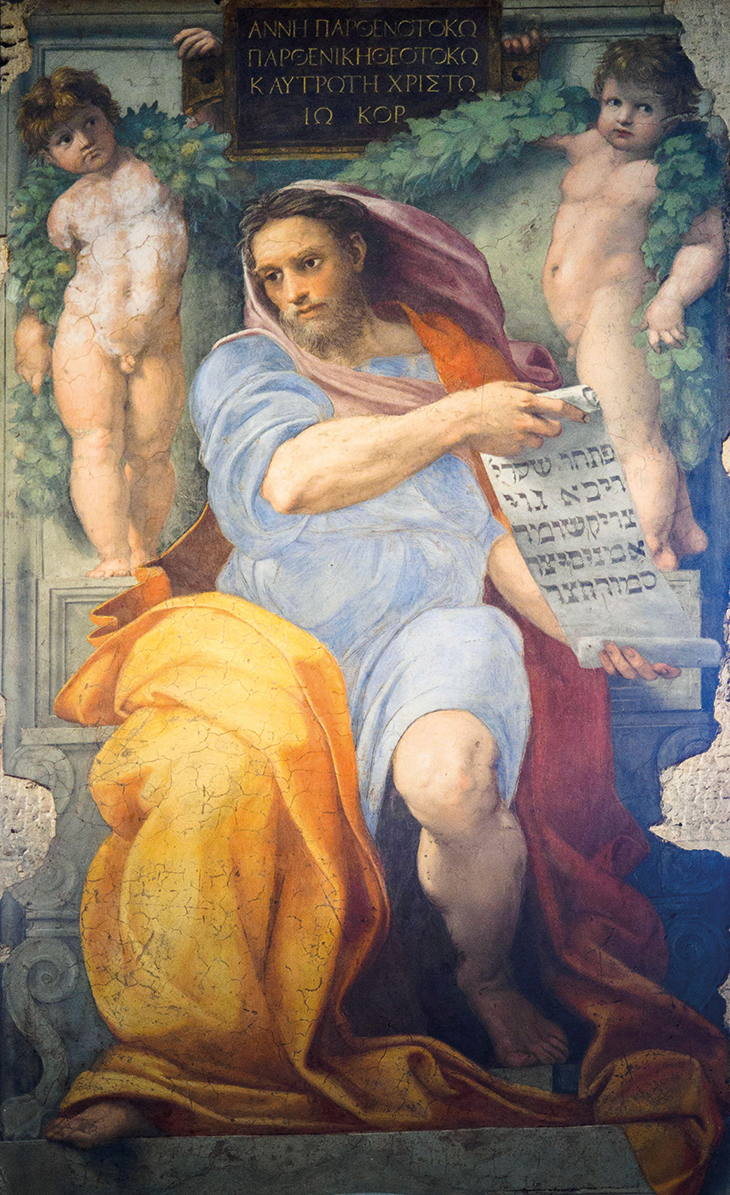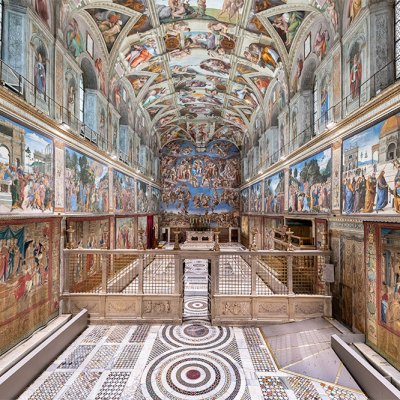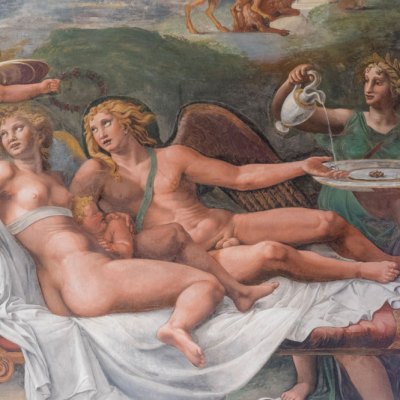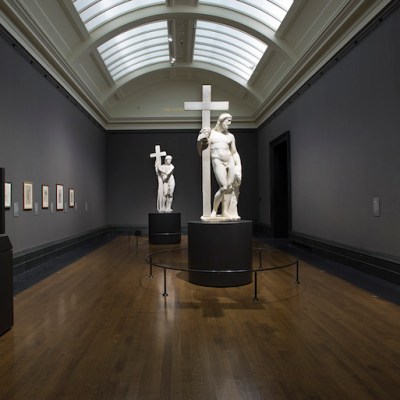Raphael died shortly after 10pm on 6 April 1520 – Good Friday – at the age of 37. Seizing on the anagogical significance of the date, one of the many stricken observers reporting on his death from the papal court remarked, with some chronological licence, that just as at Christ’s Crucifixion, the heavens willed a sign of profound grief, causing the walls of the Vatican palace to rupture. The Christological analogy was reinforced by the funerary tableau staged after his death, when his body was laid out on a bier beneath his final painting, the Transfiguration. Emerging from the darkness like an apparition, the radiant Christ, transcendent in an explosion of divine light, must have struck the mourners as a portrayal of the artist himself, whose Christ-like features had been remarked on in his lifetime. Then, in accordance with his wishes, Raphael’s earthly remains were interred in a tomb in the Pantheon (for centuries a consecrated church but originally a temple to the pagan gods of antiquity). There was no more symbolically resonant space in Rome. His burial there fuelled the nascent hagiography of the ‘Prince of Painters’ – the enduring epithet conferred on Raphael while he was still alive by the brilliant humanist Celio Calcagnini.
The Transfiguration (1518–20), Raphael. Pinacoteca Vaticana, Vatican City. Photo: Ian Dagnall Computing/Alamy Stock Photo

In the centuries after his death, the cult of Raphael grew, promoted in academies across Europe and championed by devout adherents like Ingres. It is not surprising, then, that the opening of his tomb in September 1833 was greeted with the heightened anticipation and solemn ceremony attending the exhumation of a saint. All Rome talked of nothing else, according to the architect Carlo Falconieri, who witnessed the events. As if for a blockbuster exhibition, tickets were issued for viewing Raphael’s skeleton in the Pantheon, and in the course of the six days it was displayed in a glass case before being reinterred, more than 3,000 people filed past.
The canonical view of Raphael as agreeable, well-mannered and endowed with a sweet, even angelic, disposition was articulated by the biographer Giorgio Vasari in the mid 16th century. And while this characterisation has the ring of a literary trope (as it became in the words of the artist’s friend Baldassare Castiglione, author of The Courtier, and of the humanist polymath Polydore Vergil, both of whom played on the saintly nature implicit in his surname, Santi), it undoubtedly contains elements of truth. His father, Giovanni Santi, court artist to the Duke of Urbino, had painted the young Raphael as a child-angel standing beside the Madonna and Child, and an early patron and protector praised his gentility in a letter of introduction to the head of the Florentine Republic in 1504. (The letter’s authenticity has been doubted but is today accepted by most scholars.) Years later in Rome at the height of his success, the frenetically overworked artist did not forget his manners – at least until provoked: a continuous chain of correspondence lasting more than three years records the relentless and ultimately futile efforts of the Duke of Ferrara, Alfonso d’Este, to procure a painting Raphael had long promised him. Charged with hounding the delinquent painter, the duke’s agents in Rome dutifully relayed the always fulsome, if hollow, replies to their entreaties. Eventually, the obliging pretext was dropped and Raphael, whose mounting irritation is clear, simply evaded the unwelcome messenger. Whether Alfonso’s fulminating admonition that Raphael had no business treating a duke like a lowly commoner was ever delivered is unknown.
The Opening of Raphael’s Grave in the Pantheon, 1833 (1836), Francesco Diofebi. Thorvaldsens Museum, Copenhagen

This chink in his armour of politesse signals a more complex character than the two-dimensional depiction of Raphael as unfailingly sweet and sunny – the antitype of the dour and acerbic Michelangelo – accommodates. But a less worshipful, more nuanced portrayal is the more historically accurate one. There is no doubt that Raphael was indeed genial, polite, sociable, and genuinely fond of and beloved by his many friends and associates. At the same time, he was ambitious, competitive, conspiratorial, and occasionally ruthless in his single-minded climb to the top – less attractive aspects of his character that have recently begun to come into focus. If one or two early anecdotes are to be believed, while never a practical joker, Raphael also had a quick wit and waggish sense of humour. Though long and apparently reluctantly betrothed to the niece of a powerful cardinal, he eluded the snares of matrimony himself while orchestrating a marriage alliance between two of his disciples and creating out of his workshop a tight-knit familia. He acquired vast wealth that allowed him to invest in real estate, and also to bankroll impecunious friends and acquaintances. And while he was paid handsomely for his labours, there are hints in the contemporary record of some shady dealings. On the 500th anniversary of his death, it seems a fitting exercise to sift through documents and other evidence from his lifetime in order to piece together and resurrect this more complicated Raphael, starting with his bones in the Pantheon.
The exhumation of Raphael’s remains was initiated by the Accademia di San Luca, which possessed a skull long held to be that of the Prince of Painters. Goethe, who saw the venerated relic in Rome in 1781, likened it to ‘a beautifully polished shell’. Plaster casts abounded (Goethe himself owned one), including an example in London which was subjected to rigorous phrenological analysis. The findings of that investigation were presented in a lecture delivered in the 1820s by the president of the Phrenological Society, William Scott, who charted the relationship of the shape and size of Raphael’s cranium to his character and genius. The object of this inquiry, like the pseudoscientific methodology itself, was soon discredited, however. Persistent doubts about the skull are in fact what precipitated the opening of Raphael’s tomb in the 19th century. Written accounts by several eyewitnesses and drawings of the proceedings by the painter Vincenzo Camuccini confirm that his skeleton, skull included, was found perfectly preserved and intact.
Raphael’s Skeleton at the Opening of his Tomb (c. 1833), Giambattista Borani, after a drawing by Vincenzo Camuccini. Thorvaldsens Museum, Copenhagen

The opportunity to scrutinise Raphael’s remains was not wasted, and numerous detailed observations were made at the time. His skeleton measured seven palmi, five oncie, and three minuti, making him just under five feet, six inches tall; he had a long neck, delicate arms and chest, and rather strong legs and feet; and his teeth, intact, were handsome. Long hours drawing and painting were the conjectured cause of the distortion observed in the bones of his thumb and one of his fingers. The narrow casket implied that he had been slender. A great surprise, which shocked observers at the time, was the anatomical indication of an unusually sizeable larynx, implying a loud voice. The skeletal remains do not contradict testimony from Raphael’s lifetime, including his self-portraits, that speaks to his pleasing and graceful appearance. Reanimating and projecting him into the setting of his large and noisy workshop (portrayed by his collaborator Giovanni da Udine in a stucco relief in the Vatican Logge) conjures a picture of the artist on his feet, making himself heard over the din.
Pilaster reliefs depicting scenes from Raphael’s workshop (1518–19), Giovanni da Udine. Palazzo Pontifici, Vatican City

If Raphael’s bones make it possible to imagine his physical resurrection, they are silent about the spirit that inhabited them. However, as noted, glimpses are preserved in documents dating from his lifetime and other early sources. A perfunctory survey of Raphael’s career trajectory makes clear the existence of an unwavering ambition alongside his legendary affability. Launching himself in Umbria, where he eclipsed the competition, he flawlessly emulated (appropriated would not be a wrong description) the manner of Perugino, the pre-eminent local talent and most famous painter in Italy at the time, only to shed it upon relocating to Florence and processing the artistic innovations of Michelangelo and Leonardo, leaving the mystified Perugino to wonder at his own obsolescence. In Florence, his geniality opened doors to closed artistic circles and wealthy patrons’ palaces, though one Florentine friend, the architect Baccio d’Agnolo, later deemed Raphael his ‘capital enemy’ when, long absent from the city, the artist parachuted into a competition to design the facade of San Lorenzo. Called to Rome by Pope Julius II in 1508, Raphael acquitted himself so brilliantly in the Stanza della Segnatura that the painters who were already at work in the papal apartments in the Vatican were dismissed, a turn of events they cannot have welcomed. From that position of privilege, aided by the architect Bramante, he made a clandestine visit to the Sistine Chapel – without Michelangelo’s permission – to see the frescoes in progress. For Raphael, the encounter was transformative. (His Isaiah is an undisguised paraphrase of Michelangelo’s prophets; to label it a homage is to impute a noble intention that was not the opportunistic Raphael’s motivation.) For the enraged Michelangelo, it was an unforgivable violation – grounds for his bitter, lifelong lament that everything Raphael knew he had learned from him.
The Prophet Isaiah (1511–12), Raphael. Church of Sant’Agostino, Rome. Photo: Stefano Ravera/Alamy Stock Photo

From then until his death, Raphael was the pope’s painter. Under Julius’s successor, Leo X, his remit expanded to encompass architecture (he was named architect of St Peter’s following Bramante’s death) and antiquities, in sum, virtually every venture of artistic significance in Rome. Unrivalled success did not quell his competitive streak, however – or perhaps his competitive streak helped ensure his hegemony. In 1520, a correspondent of Isabella d’Este communicated that Raphael had thwarted a young Florentine follower of Michelangelo who was trying to find work in Rome. The identity of this unfortunate is unrecorded, but there is no doubt who was the primary trigger of Raphael’s competitive instincts: Sebastiano del Piombo, Michelangelo’s disciple and proxy in Rome. (Though its meaning has been debated, Sebastiano’s cryptic reference to the ‘prince of the synagogue’ [principe de la Sinagoga] in a letter to Michelangelo may describe his view of the workshop run by Raphael, the derided subject of the letter, as an impenetrable cabal; a similar terminology suggestive of a closed religious society, setta [‘cult’], was used in an unflattering way to describe the monopolistic operation later presided over by Raphael’s collaborator Antonio da Sangallo.) When the two were pitched in direct competition through the dual commission for a pair of monumental altarpieces for the cathedral of Narbonne awarded by Cardinal Giulio de’ Medici, Raphael endeavoured mightily to derail Sebastiano’s efforts. This news was conveyed in a letter to the absent Michelangelo from a loyal partisan apprising him of the goings on in Rome, who claimed that Raphael was moving heaven and earth in order to stymie Sebastiano, but neglected to disclose the details of whatever machinations took place. Undeterred, Sebastiano set to work while looking over his shoulder for fear that Raphael, who had yet to begin, would spy on his progress. And when he undertook to have his finished picture framed in Rome to show it to the greatest advantage, Raphael attempted to intervene to see that it was done instead in France. (His sabotage campaign failed.)
No such animus coloured Raphael’s interactions with his assistants and collaborators. For them, he had a deep affection that ran to the paternal. Vasari repeatedly makes this point in his biographies of Raphael and his principal disciples, the painters Giulio Romano, Gianfrancesco Penni, and Perino del Vaga, and the sculptor Lorenzetto: Raphael loved each of them as though they were his own sons, and they in return loved him with filial devotion. There is no evidence to suggest that he routinely meddled like a parent in their personal lives, though he did on one occasion play matchmaker: according to Castiglione, it was Raphael’s wish that Lorenzetto wed Giulio’s sister Gerolama. Long in the works, the marriage took place in 1523. What emerges from this and other snippets is that the workshop was more than a strict business operation, and that Raphael’s collaborators were part of his, and each other’s, private lives. Demonstrating this, two of them – his printmaker Marcantonio Raimondi and factotum Il Baviera (Baviero de’ Caroccio), who was his pigment grinder, print dealer, picture-frame gilder, and the caretaker of his mistress after his death – represented the absent painter in his purchase of a house on the Via Sistina (Borgo Sant’Angelo) near the Vatican in November 1515. And no fewer than three – Giulio Romano, Giovanni da Udine, and the goldsmith Antonio da San Marino – named their sons Raphael.
Self-portrait (1506), Raphael. Gallerie degli Uffizi, Florence

Real estate consumed no small part of Raphael’s scarce non-working hours and abundant financial resources. By 1517 he owned the Palazzo Caprini on the fashionable Via Alessandrina (the Borgo Nuovo), designed by Bramante; in May 1518, he finalised the purchase of a vigna near the Colosseum (again an artist friend, the above-mentioned Antonio da San Marino, represented him in the transaction); and on 24 March 1520, two weeks before his unforeseen death, he acquired a parcel of land on the Via Giulia where, it has been speculated, he intended to build a grand new palace. This he would have designed himself, harnessing his unusual expertise in chimneys and flues. In addition to owning property, Raphael held a number of salaried official appointments that supplemented his already handsome income (an example Giulio Romano followed). His wealth brought him social standing and its appurtenances, including a horse – its existence is known through his documented purchase of hay – and it fuelled his generosity with friends and colleagues. There are at least two recorded instances of his lending money to fellow artists. Both neglected to pay him back.
If Sebastiano del Piombo is to be believed, not all Raphael’s financial dealings were above board. In a letter to Michelangelo of July 1518, he claims that Raphael was skimming the papal coffers and cheating the pope of three ducats per day by charging him for gold. Sebastiano was ever the grumbling victim when it came to Raphael so it would be easy to dismiss this accusation as a smear campaign were it not for Vasari’s strange reference to hidden recesses in the fabric of the papal apartments in the Vatican palace, constructed on Raphael’s orders, where his friends could stash casks and wagons. The implication is clandestine favour and a purloined cache – a skimming from the papal store consistent with the padding of accounts Sebastiano unmasked. At the very least, dubious corner-cutting was taking place. (Vasari says that the structural walls, weakened by these hollows, needed to be shored up.) Exactly what sort of murky dealings, with their whiff of privileged impunity, are hinted at must be left to the imagination, but the takeaway is that Raphael was not above skirting the rules.
From here, it is no great leap to the cheeky Raphael who mocked two German cardinals in an anecdote told by Castiglione (the overly red cheeks they criticised in a portrayal of Saints Peter and Paul were because he had depicted them blushing in shame that the church was ruled by such ignoramuses); or who offered as a witty retort to a lady professing offence at an erotic detail in his mythological frescoes in Agostino Chigi’s villa that an even lewder one had earned only her praise, this exchange recounted by Paolo Giovio. Giulio Romano is credited with being the originator in Raphael’s circle of erotic imagery stripped of the exculpatory guise of mythology or poetry: the scandalous I Modi, 16 engravings by Marcantonio Raimondi of people having sex based on Giulio’s designs, caused an uproar in Rome when they appeared – after Raphael’s death – in 1524. But drawings by an artist-visitor to Raphael’s workshop, Cesare da Sesto, prove that such material was produced during his lifetime, if not by the master himself (whose insatiable sexual appetite the disapproving Vasari blamed for the artist’s premature death, which he ascribed to a fever contracted after a night of excessive indulgence), then at least with his knowledge. Whether any of these images contained sly references to Raphael’s libidinous behaviour, which was well known to his inner circle, and his consuming love for his mistress Margherita Luti (apocryphally known as La Fornarina) – which prompted his impatient patron Agostino Chigi to install her at his villa in order to induce the distracted painter to report for work – can only be guessed at.
Portrait of Raphael, Seated (c. 1517–19), Marcantonio Raimondi. Los Angeles County Museum of Art

Assembling these disparate pieces of biographical data results in an image of Raphael that is more well-rounded and psychologically complex than the beatific portrait of past centuries. While he was undoubtedly sweet, well-mannered, kind, and generous, Raphael was also competitive, ambitious, entitled, and perhaps, at times, even a little unscrupulous. Affable when it mattered because of a patron’s stature or a friend’s affection, he could become prickly when overwhelmed by the crushing demands placed on him, hence the promise of Alfonso d’Este’s dogged agent to handle him with kid gloves. Though his analysis that Raphael was prone to artistic melancholia was a bromide, the observation was not entirely untrue. This is the Raphael captured in Marcantonio Raimondi’s engraved portrait: withdrawn, brooding, overworked (an untouched panel, palette, and paint pots await), barricaded in the mantle he bequeathed to his beloved disciple Giulio Romano, who cherished this relic of Raphael enough to make provisions for it in his will.
The German Nazarene painter Johann Friedrich Overbeck was among those present in the Pantheon for the opening of Raphael’s tomb. He wrote of being so moved that ‘a shudder came over me when the remains of the honoured painter were laid open’. At the same time, he reflected with melancholy, ‘Alas, the spirit of the great artist remains buried deeper than his bones.’ Raphael’s bones remain buried but, 500 years after his death, his spirit is closer at hand.
From the July/August 2020 issue of Apollo. Preview and subscribe here.


